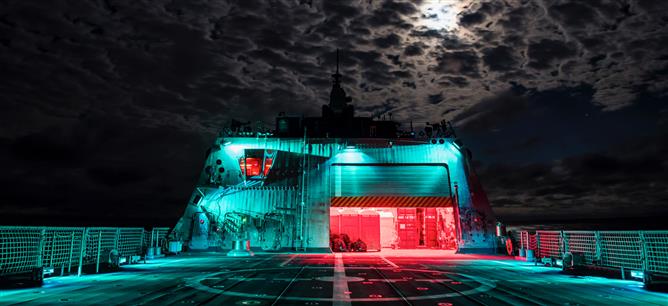USS Little Rock production crew to visit city, meet with members of USS Razorback
by September 11, 2017 9:25 am 912 views

Night image from the Helo deck aboard the USS Little Rock, LCS9 Littoral Combat Ship made by Lockheed Martin for the U.S. Navy.
Lockheed Martin’s production team for the USS Little Rock is headed to the capital city on Tuesday to meet local officials and to hand out promotional materials to be shared with Arkansans about the U.S. Navy’s newest stealth warship.
Nearly a month ago after completing successful “sea trials,” the U.S. Navy’s Board of Inspection and Survey (INSURV) conducted inspections and witnessed final demonstrations for the Littoral Combat Ship, or LCS 9, Lockheed Martin spokesman John Torrisi told Talk Business & Politics.
Those five-day trials, conducted in port and at sea by INSURV, included comprehensive tests of the LCS intended to demonstrate the performance of the USS Little Rock’s propulsion plant, ship handling and auxiliary systems, representing the last major milestone before the ship’s delivery.
The Navy’s newest LCS warship will be commissioned next to her decommissioned namesake battleship in Buffalo, N.Y., later this year. Before that happens, the ship’s production crew is making the visit here to honor the patriotic and hardworking citizens of Little Rock as the LCS 9 will be the second U.S. Navy ship to bear the name of Arkansas’ largest city.
Besides meeting with local officials, the USS Little Rock production crew also plans to visit the Arkansas Inland Maritime Museum. There, they plan to meet with members of the grounded USS Razorback that now houses the naval exhibition on the Arkansas River in North Little Rock.
“We are excited to go,” Torrisi said. “One of the things we hope to leave behind is the exhibit for the local museum so people will understand the newest addition to the Navy and hopefully one day see the ship in person.”
All the other details of the trip to Little Rock have not yet been finalized due to complications related to Hurricane Irma in Florida, where the defense contractor has several locations that employ thousands of workers. The USS Little Rock will eventually be ported at the Naval Station Mayport near Jacksonville, Fla., where it will deploy on missions around the world for up to 16 months.
Called the “smartphone of the seas,” the LCS is the Navy’s newest class of warship that comes in two variants, the Freedom- and Independence-class. Under the Navy contract award, Lockheed Martin was appointed to build the Freedom-class LCS warships at its shipyard facility in Marinette, Wis.
“The thing that sets this ship apart from all other warships is the technology,” Torrisi said.
Once the ship’s 70-person Navy crew has been properly trained and the warship commissioned for duty, the Little Rock will be designed to defeat growing threats and provide access and dominance in the coastal waters. Torrisi said the warship will be “focused-mission,” meaning that it is adaptable to environs where it operates. Nearly 40% of this LCS version can be reconfigured for three different roles, including anti-submarine tactics, mine countermeasures and anti-surface warfare.
“This ship is designed so we can plug and play,” he said.
During the test runs for the USS Little Rock at Lake Michigan in August, the small surface LCS reached speeds of up to 40 knots, which is equal to about 46 miles per hour. Littoral is a term meaning close to shore. The ship is 378 feet in length, has a waterline beam of 57 feet, and displaces approximately 3,000 tons.
According to some media reports, the crew of the new stealth warship may be headed to a diplomatic hot spot in the South China Sea, where the U.S. and China have both conducted war games in the disputed waters.
“There are over 50,000 ports between the Philippines and Sri Lanka. In the past, the (Navy) could only access 50 ports, but now we will be able to access over 1,000,” Torrisi said. “That shows this ship’s flexibility.”
The Lockheed Martin team is on track to complete sea trials for LCS 9 and LCS 11 this year and deliver each ship shortly thereafter. The defense giant has already commissioned the odd-number LCS 1,3,5 and 7 Freedom-variants that include the USS Freedom, USS Fort Worth, USS Milwaukee and USS Detroit, respectively.
The remaining hulls under contract will be delivered to the U.S. Navy at a rate of two ships per year. The Lockheed Martin-led LCS team is comprised of shipbuilder Fincantieri Marinette Marine, naval architect Gibbs & Cox, and more than 800 suppliers in 42 states.
General Dynamics Australian shipping giant Austal USA is the contractor for the Navy’s Independence LCS class, which are even-numbered littoral ships with a different hull design. Last year, the Pentagon announced that it would cap the current buys of both variants of LCS at 26 ships — 13 each per class but 26 less than the Navy had planned.
